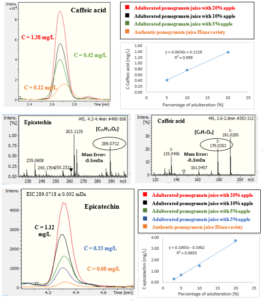Fruit juices
Fruit juices have been in the top 7 foods reported from 1980 to 2010 as the most common targets for adulteration. Several fruit juices, as orange and pomegranate juice, have become popular with regard to high levels of antioxidants, presumed to be associated with positive health effects. Similarly to other highly prized food commodities, the economic value and large-scale production of these valuable fruit juices have made them a likely target for adulteration and fraud.
In TrAMS group the main objective is to explore the feasibility of targeted and untargeted analysis, using high resolution mass spectrometric techniques (HRMS), to discriminate authentic and adulterated fruit juices.
Our main research interests comprise to:
Chemical Characterization of fruit juice samples of different varieties and/or geographical origin
Study of fruit juice phenolic fingerprint
Detection of trace level adulteration
Geographical Origin Discrimination
Botanical Origin Discrimination
Application: Detection of pomegranate juice adulteration
Pomegranate juice is one of the most popular fruit juices, is well-known as a “superfood”, and plays an important role in healthy diets.
Due to its constantly growing demand and high value, pomegranate juice is often targeted for adulteration, especially with cheaper substitutes such as apple and red grape juice.



The combination of metabolomic profiling, metabolomic fingerprinting and chemometrics provided a powerful approach for detecting pomegranate juice adulteration with apple and red-grape juice at very low adulteration levels (down to 1%)
Marker compounds were detected and identified using target, suspect and non-target screening HRMS approach
Target screening results were used to differentiate authentic pomegranate, apple and red grape juice samples

